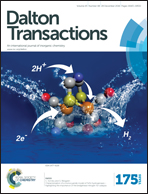Photo-induced magnetization and first-principles calculations of a two-dimensional cyanide-bridged Co–W bimetal assembly†
Abstract
A two-dimensional cyanide-bridged Co–W bimetal assembly, (H5O2+)[Co(4-bromopyridine)2{W(CN)8}], was prepared. A synchrotron radiation (SR) X-ray single-crystal measurement shows that the crystal structure is monoclinic in the P21/c space group. Magnetic and spectroscopic measurements show that this assembly takes CoIIIlow-spin(S = 0)–WIV(S = 0) in the temperature range of 2–390 K. Such a wide temperature range CoIIIlow-spin–WIV phase has not been reported so far. First-principles calculations show that the band gap is composed of a WIV valence band and a CoIII conduction band. 785 nm light irradiation causes photo-induced magnetization with a Curie temperature of 27 K and a coercive field of 2000 Oe. The crystal structure of the photo-induced phase was determined to have larger lattice constants in the two-dimensional layer (bc-plane) by 3% compared to the original phase, which is due to the expansion of the distance of Co–N. The photo-induced phase returns to the original phase upon thermal treatment. First-principles calculations, and magnetic, and optical measurements prove that this photomagnetism is caused by the optical charge-transfer-induced spin transition from CoIIIlow-spin(S = 0)–WIV(S = 0) to CoIIhigh-spin(S = 3/2)–WV(S = 1/2).


 Please wait while we load your content...
Please wait while we load your content...